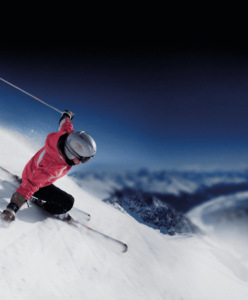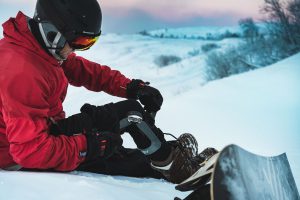SKI TRAINING & INJURY MANAGEMENT
Did you know, an estimated 45,000 people will become injured skiing this year, and 4,500 people with pre-existing injuries will need help protecting their knees on the slopes this Winter?
Endurance athletes always practice before a race. Skiing is no different. You need to prepare your body before you hit the slopes.
About six weeks out, you should implement a ski-specific program that mimics skiing or snowboarding moves.
Ski injuries are common as skiing places different demands on the body than other year-round sports and activities. It is vital to get fit for skiing as this will reduce your chance of picking up aches and pains and enable you to enjoy your holiday more.
Being physically prepared to ski should also improve your performance on the slopes.

Top training tips to improve your performance whilst skiing:
Strengthen the quadriceps
The quadriceps muscles (at the front of the thigh) work hard during skiing and snowboarding. They are probably the most used muscle group. These muscles work to hold you in position as well as to bend and straighten the knee. The controlled lengthening of the quadriceps muscle from straight to bent is called eccentric training. Eccentric training is vital and is often overlooked as part of winter snow sports training.
Try adding squats, lunges, split squats and step downs to your lower limb training regime.
Strengthen the glutes
When skiing downhill, the glutes help to hold your body in a flexed position when leaning forward from the hips. They are one of the largest muscle groups used in skiing and snowboarding. It is important to train both your gluteus maximus and gluteus medius as they work differently to support the body during snow sports.
Try adding bridging, single leg squats, clams or resisted crab walks to your exercise programme to help strengthen the glutes.
Ensure good spinal and hip mobility
Mobility and stretching exercises to improve and maintain spinal movements are vital in your pre-ski preparation. Snow sports use a wide range of movements that are sudden and often unpredictable, which can be stressful for muscles and ligaments. The downhill ski position involves prolonged hip flexion so stretching the hip flexors can be important in recovery after a day skiing.
Seeing a physiotherapist for spinal and hip mobilisations, soft tissue treatment and guidance on stretches is a great way of ensuring good spinal and hip mobility for skiing.
Train the core and back
Skiing for prolonged periods in a flexed position works the back and core hard. It is important to have a strong back and an active core, which combined with strong glutes, will help reduce your chance of picking up a back injury whilst skiing.
Attending a regular Pilates class is a great way to improve your back and core strength, and supervision from a physiotherapist will ensure you’re activating your core in the correct way.
Proprioceptive training
The body’s sense of its position in space is called proprioception. This is important when skiing on uneven or icy slopes as it helps to keep control of the position of your legs. It is especially useful in bad visibility and when landing from jumps or moguls.
Try standing on 1 leg with your eyes closed for as long as you can. Repeat this twice a day in the months before skiing.
Our 5 Top Tips for Preventing Injury
- Screening and prevention.
One of the best ways to avoid injury is often overlooked, that is injury prevention screening. Ideally all skiers should be fully screened for potential problems before the start of their ski training. Dealing with injuries when they occur is understandable, but often these injuries could be avoided with a more individualised approach to preventative training and exercise.
- Knee position.
Positioning your knees centrally over the feet enables skiers to carve properly and helps snowboarders to feel more stable. Keeping good knee alignment can reduce knee pain by relieving pressure on the kneecap and tendons. Check this by placing your feet in the ski or snowboard position with your knees bent. Focus on the center of the kneecap and imagine a vertical line down to the floor. This line should fall between your 2nd and 3rd toes.
- Pelvic position.
Skiing with your bottom sticking out too much or tucking it under too far can make it difficult for your muscles to work optimally. To ensure good technique, tilt your pelvis forwards and backwards and have a look in a mirror to see the 2 extreme positions. Find the middle position between these 2 pelvic positions (called pelvic neutral) and try to hold your pelvis in this position. Holding this position whilst adopting your skiing or snowboarding position retrains your body so it is more likely to hold this position when you are performing your Snowsport.
- Explosive training.
Once you’ve improved your quads and glutes strength, you can move onto explosive training. It is really important to be able to propel yourself into the air, especially if you are off-piste or on moguls. Add jumps and hops to your training and a physiotherapist can help to work on this through plyometric training.
- Cardiovascular training.
To reduce that feeling of tiredness halfway through your holiday, it is vital to train your cardiovascular system. Interval training is a time efficient way to do this. Cycling or the step machine use some of the key muscles used when skiing or snowboarding so can be a good way to make your interval training specific.
Injury Management and DONJOY Knee Braces
Unfortunately, despite the best preparation, sometimes injuries will occur on the ski slopes.
Early assessment, diagnosis, treatment and management of the injury is essential. MSO Physio has great links with sports medicine doctors and orthopaedic consultants as well as a great team of physiotherapists, sports massage therapists and Pilates instructors to look after you in the event of an injury or following surgery.
We are an authorized sales and fitting Centre for Donjoy knee braces which can be used in the prevention and management of ski injuries. The use of a Donjoy brace combined with physiotherapy can help you to return to full fitness following an injury or following surgery.
